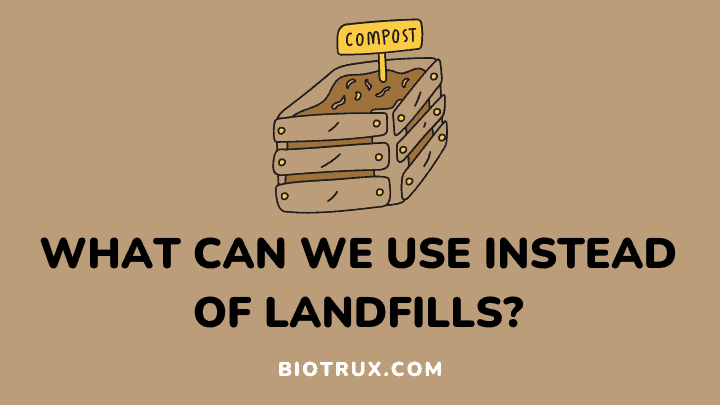It’s no secret that landfills are becoming an increasingly problematic feature of the modern landscape. Every day, we’re producing more and more waste than ever before, and traditional landfill methods are struggling to keep up with the tidal wave of trash.
In light of this, it’s time to rethink our waste disposal methods and explore new, sustainable alternatives. Thankfully, there are many ways in which we can reduce our reliance on landfills and create a more sustainable future.
In this article, you’ll explore the alternatives to landfills, from composting to recycling and everything in between. You’ll also examine each alternative’s benefits, examples, and challenges. So, if you’re ready to take action and positively impact the planet, keep reading.
What Can We Use Instead of Landfills?
1. Recycling

Recycling is a great alternative to utilizing landfills, as it helps divert our waste away from these finite repositories. Rather than simply disposing of our garbage, we can engage in recycling, which breaks down materials into their components and converts them into reusable products.
In addition to reducing pollution, this reduces the amount of wear and tear landfills suffer due to overburdening. Furthermore, recycling helps us reduce emissions in the broader environment, contributing positively towards achieving sustainability goals.
Benefits of recycling
1. Recycling reduces the amount of waste in landfills, which helps avoid environmental problems like soil and water pollution.
2. It also helps to conserve resources, as recycled materials can often be used to provide raw materials for new products.
3. Recycling contributes to energy conservation by reducing the need to extract, refine and process raw materials from the earth.
4. It is an economical solution, as recycling can often generate revenue by selling goods produced with recycled materials.
5. Finally, it can help to reduce greenhouse gas emissions due to the reduced need for energy-intensive processes like refining and manufacturing.
Examples of materials that can be recycled
To create a more sustainable future, recycling is an integral part of our waste management efforts. By repurposing materials such as paper, cardboard, glass, metals, plastics, and electronics, we can reduce waste sent to landfills and conserve valuable natural resources.
Recycling not only protects our planet but also allows for the creation of new products out of reusable materials. This preserves both our environment and our economy.
Challenges of recycling
1. Cost: While the cost-efficiency of recycling can be realized in the long run, the upfront costs associated with equipment and personnel make it a difficult sell.
2. Infrastructure: Developing an effective recycling infrastructure requires the collaboration of multiple entities like animal welfare groups, local businesses, technology, and municipal governments, making it a challenging endeavor.
3. Low re-use value: Many recycled materials lack a high re-use value due to improper segregation, contamination, and wear and tear, leading to lower prices.
2. Composting

Composting is an intelligent and sustainable alternative to traditional landfills that dispose of waste matter. Our everyday food waste can often be reused to nourish the environment through composting.
This efficient practice is done by breaking down biodegradable materials such as fruit peels or vegetable scraps into a nutrient-rich soil additive that can be used for agriculture.
Not only can this be a great solution to reducing landfill sites, but it also contributes to healthy soil and plant life in an ecologically beneficial way.
Benefits of composting
1. Composting significantly reduces the amount of solid waste sent to landfills, which can help clean up our cities and landscapes. Furthermore, composting is cost-effective.
2. It produces nutrient-rich soil amendments that can be used in gardens and farms, reducing the need for chemical fertilizers.
3. When organic matter is composted instead of sent to a landfill, it breaks down naturally without releasing greenhouse gases like methane into the atmosphere.
Examples of items that can be composted
Composting is a great way to reduce waste and provide essential nutrients to your garden. Items like fruit and vegetable scraps, coffee grounds, tea bags, eggshells, grass clippings, leaves, and paper can all be composted to create nutrient-rich soil amendments.
Challenges of composting
1. Space and location: Composting requires space, ideally in a large and dry backyard or other areas away from residential areas. To ensure successful composting, good air circulation is also necessary.
2. Time investment: Composting can take a few weeks to several months for the material to break down completely, depending on the conditions. This can be inconvenient for those who do not have much time to devote to the process.
3. Learning curve: Before composting properly, it takes some learning about what materials can (and cannot) be composted and how to maintain a good temperature and oxygen levels.
3. Waste-to-Energy

Waste-to-energy (WTE) converts discarded materials into energy for industrial and commercial use. WTE utilizes advanced technology to safely incinerate municipal waste such as plastics, paper, and organic material, harnessing the heat to power turbines and generate electricity.
It is a sustainable solution to the growing global problem of landfill overload. It provides an alternative source of energy that diminishes our reliance on fossil fuels.
Plus, the ash created during burning can be recycled in other industries. WTE offers a future of clean, green energy production and should be strongly considered in any policy discussions about how best to protect our planet.
Benefits of waste-to-energy
1. Waste-to-energy technology offers an alternative to landfills, providing a cleaner, more efficient way of disposing of waste while reducing greenhouse gas emissions.
2. Waste-to-energy facilities can produce energy from various types of waste, such as food, paper, plastics, and even hazardous materials. This helps conserve natural resources such as fossil fuels.
3. Normal landfill waste can take hundreds of years to break down, but with waste-to-energy plants, the process is much faster, allowing the waste products to be repurposed in a shorter time frame.
Examples of waste-to-energy technologies
Waste-to-energy technologies are becoming more popular as an effective solution to our growing waste crisis. These technologies use a variety of processes, from incineration, gasification, and anaerobic digestion, to convert various kinds of waste into energy.
For instance, some waste-to-energy facilities use advanced thermal combustion systems to generate clean electricity from municipal solid waste.
A waste-to-energy technology can also use biogas from landfills or convert organic materials, such as fats, oils, grease, food residues, and agricultural byproducts, into useful fuels.
By implementing these strategies, we can begin to reduce the amount of waste that enters our environment while also providing clean, renewable energy sources.
Challenges of waste-to-energy
1. Limited Capacity: Waste-to-energy plants have a finite capacity to convert waste into energy. As such, they may be unable to handle the full amount of waste that needs to be disposed of.
2. Environmental Impact: Although burning waste can produce energy more efficiently than landfills, the process still generates emissions like particulate matter, carbon dioxide, and nitrogen oxides which may contribute to air pollution.
3. Cost: Running a waste-to-energy plant requires significant investment in equipment and infrastructure, making it more expensive than other waste disposal methods.
4. Reduction of waste

With our world in a state of environmental crisis, we must embrace new methods of dealing with waste.
One such solution is the reduction of waste. It involves reducing the amount of material and energy consumed during production and emphasizing reuse and recycling strategies to limit resource depletion.
This is particularly effective in places where landfill capacity is limited, allowing us to extend the life of existing landfills and prevent the need for more.
By eliminating our reliance on landfills, we protect our environment and safeguard human health by preventing the spread of pollutants and toxins.
Benefits of waste reduction
1. Reduced carbon footprint: Diverting waste from landfills reduces the methane gas released into the atmosphere, resulting in a lower overall carbon footprint.
2. Conserved resources: By reducing waste and diverting it from landfills, valuable resources like water, energy, and raw materials are conserved.
3. Improved environmental health: Reducing landfill waste can improve air and water quality, benefiting people and ecosystems.
Examples of waste reduction practices
Reusing materials and products, using energy-efficient green technologies, and reducing everyday material consumption can all help reduce waste.
Some easy waste reduction practices include turning off all lights and electronics when unused. Other tips include using grocery bags when shopping, recycling paper and plastic items, buying in bulk whenever possible, and properly discarding hazardous materials.
By implementing these simple yet effective actions daily, you can be part of the solution rather than the problem.
Challenges of waste reduction
1. Dealing with Hazardous Waste: When reducing and reusing waste, hazardous materials such as batteries and paint must be properly disposed of according to safety regulations.
2. Cost-Effectiveness: Implementing waste reduction initiatives may involve significant upfront costs, which can be difficult for organizations operating on tight budgets.
3. Education and Awareness: Effective waste reduction strategies require understanding the issue and awareness of techniques for reducing and reusing – these need to be taught and promoted to be successful.
FAQs
What can individuals and businesses do to reduce their reliance on landfills?
Individuals and businesses can take several steps to reduce their reliance on landfills, such as implementing practices such as using reusable bags, containers, and water bottles, reducing paper use, and properly disposing of hazardous materials. It is also important to support policies that promote sustainable waste management practices.
Are there any disadvantages to using alternatives to landfills?
While there are many benefits to using alternatives to landfills, there can also be disadvantages. For example, some alternatives may be more expensive than traditional landfilling, require more space or infrastructure, or require specialized equipment or expertise.
Can alternative waste management practices be implemented on a large scale?
Yes, governments, businesses, and communities can implement alternative waste management practices on a large scale. Many cities and countries have successfully implemented recycling, composting, and waste-to-energy programs on a large scale, reducing landfills and promoting sustainable waste management practices.
Final Thoughts
In our world today, landfills have become an increasingly common way of managing waste. But what if there were better options? We could switch to a more sustainable system that reduces waste and positively impacts the environment.
Composting, recycling, waste-to-energy, and waste reduction are all great ways to reduce the amount of garbage in landfills. By thinking creatively, we can develop new solutions to help reduce the amount of waste going into our landfills while positively impacting our planet.
So let’s start by imagining some of the possibilities. Sustainability starts with us all working together for a brighter future.
You should also learn more about the difference between landfills and dumps.
Thanks for reading.

